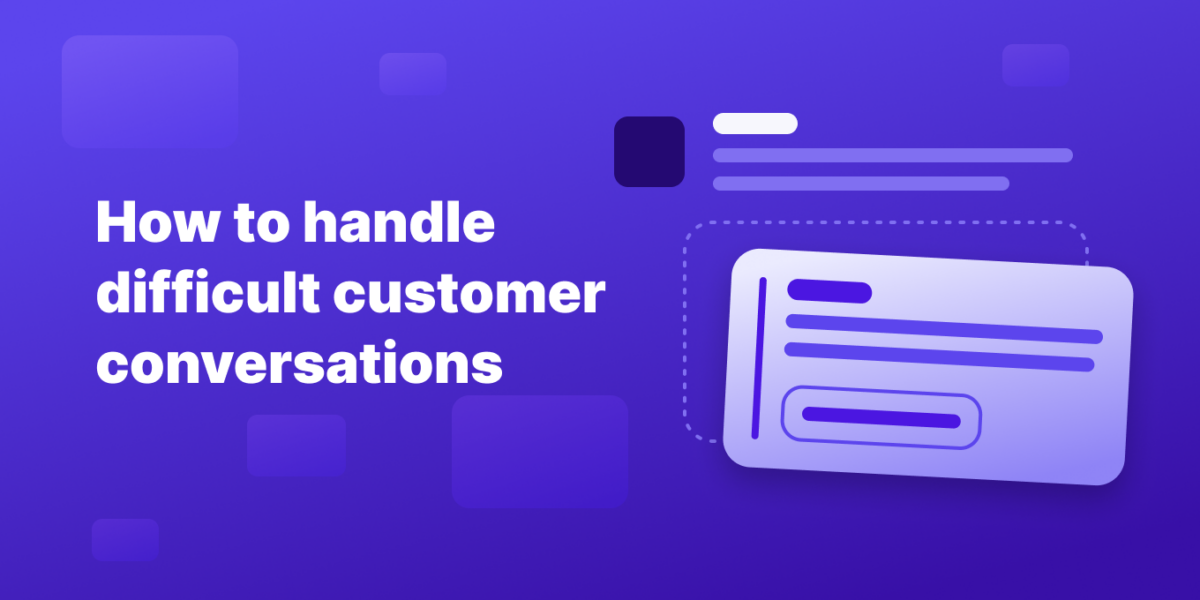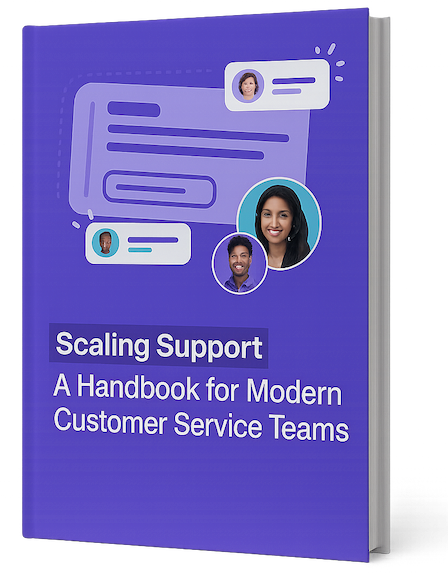Everyone’s come across horror stories from customer service about that completely unreasonable customer who raged at a poor, beleaguered employee.
Thankfully, those situations are actually pretty rare.
Difficult conversations with customers are much more common–and every agent goes through a tough learning curve in learning how to manage them well.
What are difficult customer conversations?
A “difficult conversation” isn’t too hard to pinpoint. In most cases, you’ll know them when they happen. But definitions are a great way to pinpoint why they’re challenging to manage.
The authors of the great book Crucial Conversations defined a crucial conversation as follows:
A crucial conversation is one in which:
- the stakes are high,
- opinions vary, and
- emotions run strong.
These three factors are also at play in every difficult conversation you’ll ever have with a customer.
Difficult conversations crop up in situations where there’s a complaint, a misunderstanding, a conflict, or a product issue. They happen whenever something occurs that causes emotional distress. They’re also common in customer support conversations with a high degree of complexity, because that complexity can easily cause misunderstandings or conflict later down the line.
6 steps to handle a difficult customer conversation
Helping a customer can often be simultaneously highly rewarding while being very challenging.
In fact, in many cases, the more challenging a situation is to resolve, the more rewarding it is when it’s resolved.
The three key goals that will de-escalate every difficult conversation with a customer are to:
- Diffuse the emotions.
- Find common ground.
- Lower the stakes on both sides.
Believe it or not, the order does matter. High-strung emotions are often a blocker to achieving anything else, so you have to start there.
Here’s how you handle difficult customer conversations in the real world. Add these best practices to your regular customer service workflows.
1. Take a deep breath and remain calm
It’s impossible to diffuse emotions if you’re reacting emotionally yourself. That’s why the most important step is to maintain composure.
That’s always easier said than done. If you’re coaching your agents on how to manage this, you can:
- Help them recognize their unique reaction pattern to stress. Some people try to withdraw and avoid the situation, while others get combative in response. Awareness is a good first step in helping them achieve some distance.
- Invest in anger management or stress management training. Anger management training can help in understanding how to control impulsive reactions.
- Provide resources and scripts for your agents to follow. These are a great fallback when someone starts feeling overwhelmed in a situation.
- Define a process that has their back. Agents can handle these situations better if they have a safety net. For example, encourage them to escalate cases to you or other highly experienced colleagues.
- Remind them to take a deep breath. This always sounds like a cliche, but breathing really does change how you regulate your emotions and can make a massive difference in helping you stay calm.
2. Understand the customer’s perspective
If at least one side (the agent) can approach the situation calmly, then you can start focusing on how to help diffuse the customer’s emotions.
That usually means making sure that they feel heard and understood. Truly understanding their perspective is essential to adapting your approach and finding a solution that will work for that customer.
In practice, that means asking clarifying questions like:
- “Can you please explain the situation in detail so I can better understand what’s happening?”
- “Could you provide some examples of how that’s impacted you?”
- “Could you help me understand when this started?”
- “Is there anything else contributing to your frustration that you haven’t mentioned yet?”
- “What would your ideal resolution look like?”
3. Express empathy and practice active listening
Understanding the issue in-depth is the only way to express empathy so it actually reaches the customer.
This means putting yourself in their shoes.
This is another situation where practicing role-plays can make a huge difference. Active listening involves a set of techniques that you can consciously implement:
- Paraphrasing what the customer says. “It sounds like you’re feeling frustrated because of the delays in the delivery process, is that correct?”
- Reflecting their feelings, “I can sense that it was a huge disappointment not to receive your order on time.”
- Provide verbal acknowledgement or feedback. “I understand what you mean” or “I appreciate you sharing that with me.”
- Empathizing with what they’ve said. “I can imagine how frustrating that was for you.”
- Summarizing the main points. It’s especially useful to mirror the same language back at the customer they’re using. “If I understood you correctly, what you want to see is…”
The great thing about active listening is that it often helps customers process their emotions themselves, while also helping you find common ground.
These techniques are easy to internalize if you practice them often enough, so making it possible for your agents to do that in a contained and safe environment can be very effective.
4. Acknowledge the customer’s experience
When you’ve developed a full picture of the situation, you can focus on finding points of agreement.
That doesn’t necessarily mean that you can or will give the customer everything that they want. It just means acknowledging that their perspective is right in some way.
It can be tricky to find the right balance.
Say a customer is extremely disappointed because of a company policy or decision that you just cannot change. Validating the customer’s concerns doesn’t have to come at the expense of criticizing the company, and finding a point of agreement doesn’t mean saying that you can change the situation.
The balance is in:
- Acknowledging that you can understand why they’re disappointed.
- Explaining the intention behind the current policy or decision in a way that emphasizes your dedication to a great customer experience.
- Admitting that there are still opportunities for improvement in your processes and policies and that maybe the intention you have wasn’t met in this case. The more specific you can make this, the better it will be for the customer.
Pro tip: During the conversation, try to analyze your customer’s personality and adapt your communication style to their needs. Some customers care about hard facts and numbers. Others simply want to feel emotionally validated or seek social connection. You can usually catch hints of what they’d prefer and adapt your style accordingly.
5. Express apologies sincerely
One way to feed fuel into the fire of a difficult conversation is to react defensively. Defensiveness is a sure-fire way to make your customers feel dismissed and they’ll often react by getting even more angry.
A good reminder is the lesson of the two tokens, from Chase Clemons, Head of Support at 37signals.
“When dealing with customers, especially those that are angry, there are always two tokens on the table. One is the token for “it just doesn’t matter.” It’s not a big deal. And the other token is “it’s the end of the world.” We pick one, and the customer picks the other.”
That’s why apologizing is so important. Apologies are another opportunity to find common ground. They’re a way for you to show the customer that you agree with their perspective that something went wrong.
Saying sorry is a real skill, and it takes time to develop it. But if your team or company made a mistake, it’s always better to own it and express a sincere apology. Use phrases like these:
- “I’m sorry that we fell short of your expectations.”
- “We sincerely regret the inconvenience this caused you. This isn’t the standard that we set for ourselves and we’ll definitely learn from this experience and assess how we can improve.”
- “This was an unacceptable mistake on our part. We take full responsibility for the mistake.”
- “I’m so sorry to hear you didn’t have a good experience with our product.”
6. Present options for resolution
The final step, to lower the stakes, is in looking for opportunities to resolve the situation.
Ideally, by the time you get here, the customer is already significantly calmer, you’ve developed a deep understanding of the issue they faced, and you’ve found common ground on some of the essential concerns they have.
Now it’s time to provide tailored solutions that solve the issue they’re experiencing.
Say you sell an in-app purchase, and you’re unable to action a refund that a customer has requested because the payment is handled via the App Store and is therefore controlled by Apple. You might not be able to provide the refund, but you can definitely look for other ways to compensate them, like providing them with a voucher or a gift card.
If it’s an issue with a faulty product, you can provide them with a new one free of charge. Or you can include additional hands-on support so they can rely on you to invest more time in helping them achieve the goals they’re looking for.
It’s great if you can offer at least two options so the customer has a choice and can choose the outcome that’s preferable to them.
Creating resources to support your team
Difficult conversations can be uncomfortable in the moment, but nothing beats the sense of achievement your team will get from resolving them successfully.
Equipping them with the right tools and support can help them get there significantly faster. That’s where Tettra comes in.
Tettra is an AI-powered knowledge management system that can instantly answer your team’s questions with the documentation you’ve created–which is especially important in these types of situations.


